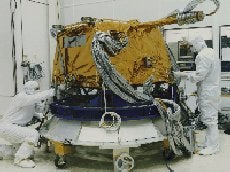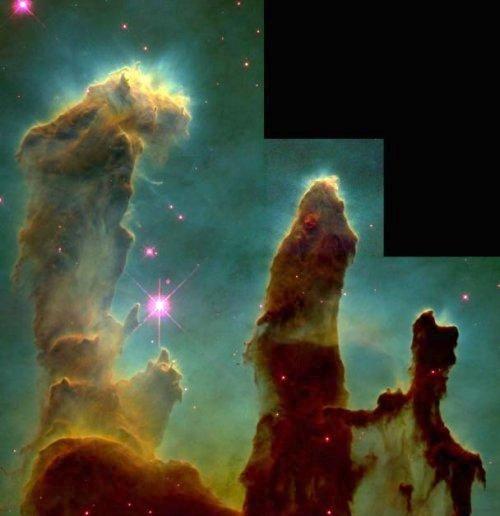And while bigger projects mean more collaborators with whom to share ideas, bigger may not always be better. Some scientists think large groups stifle individual creativity or reduce each member’s contribution to the point of triviality. One size clearly doesn’t fit all when it comes to research, as you’ll discover when you read responses to questions Astronomy asked a few graduate students about working on projects both big and small.
What is your educational background?
B. Sc. in Engineering Physics, 1994, Portugal;
M.A. in Physics, American University, 1997, Washington, D.C.; M.A. in Astrophysics, Johns Hopkins University, 1999; and Ph.D. Astrophysics, Johns Hopkins University, summer 2003.
I work with FUSE, which was launched on June 24, 1999, for a three-year mission. In the meantime, more funds have been allocated to keep the satellite running for two more years.
The main goal of FUSE in to measure the abundance of deuterium in the interstellar medium. There are other smaller goals, such as studying the hot gas content of our galaxy and the Magellanic Clouds and studying the molecular hydrogen content of our galaxy.
What is your role in this project?
I started working with FUSE two years before the satellite was launched. During that time I was responsible for monitoring the reflectivity of the flight mirrors.
After FUSE was launched I started working with FUSE data and my main goal has been to measure the deuterium abundance toward different stars in our galaxy.
How many people are involved in the whole project?
I think that at the peak of the mission around 600 people were involved in this project.
People working on this project are scattered across different universities and continents. The most important people now, are concentrated at Johns Hopkins, where we have the satellite control center. There are about 55 people here at JHU involved in the mission.
Do you feel that your contributions have a significant effect on the results?
Yes I feel that I have contributed to the results of the project.
What do you feel are the benefits of working on a project of this size? What are the drawbacks?
I think there are a couple of drawbacks, but I’m not sure that they are unique to this kind of project.
One of them is that sometimes I have to spend time doing work that won’t go directly into my thesis. This might be doing something that will help the goal of the project in general or walking a scientist through how to do the kind of analysis I’ve been working on so that they can learn the tools and do the analysis by themselves. This leads to the next point, which is working with a scientist in their analysis (and doing a big chunk of it); when the paper gets submitted they get to be first author.
Would you want to work on a project of this size again or would you prefer one of a different size?
I think this is definitely a good-sized project to work on. Of course it helps that the people who know more about the mission are located here at JHU and that the principal investigator of the mission is my thesis advisor. The size of the project is big enough that you meet many people and you can always find someone who will have some sort of answer to your problem. In addition, this provides a nice environment where you can learn a lot from other people who are working on different subjects.
On the other hand, it is small enough that you know more or less what each person is working on and you don’t feel lost. Also, the competition for data is not as large as it might be in really large projects. The people here are all very helpful and hardworking, and I’ve really enjoyed working with them.
I know from friends’ personal experiences that working in very small groups can really slow you down, especially if you’re the only person working on a particular topic and no one else has any clue about that topic!
Also from friends’ personal experiences I know that in really large projects there is typically a lot of competition to work on a particular subject, and sometimes you have small groups within the project competing with each other.
What is your educational background?
Bachelor’s in physics from the New Mexico Institute of Mining and Technology (New Mexico Tech) in Socorro, New Mexico, in 1993. In 1994, I started working as a data analyst at the National Radio Astronomy Observatory in Socorro where I had duties related to the operation of the Very Large Array and the Very Long Baseline Array. In 1996, I began at Arizona State University. I received my master’s in physics in 1998.
My dissertation topic is the formation of low-mass sun-like stars in regions of massive star formation (HII regions like Orion, Eagle, and Trifid Nebulae). We are trying to determine whether the formation of low-mass stars is affected by the presence of hot, massive stars. One aspect we are interested in is the timing between the growth of low-mass stars in the cold gas bounding the HII region and the rate at which they are exposed to the intense ultraviolet radiation of the cluster of hot stars which power the HII region. Dr. Hester began this line of research with his Hubble Space Telescope image of the Eagle Nebula and we expanded the work when I began my Ph.D. research in 1998. Through my Ph.D. research and later work, we hope to learn enough details of what happens to say whether this environment affects star formation.
What is your role in this project?
I’ve collected all the ground-based data using the Very Large Array, the VATT (Vatican Advanced Technology Telescope) on Mount Graham, Arizona, and the Bok Telescope on Kitt Peak, Arizona. Dr. Hester and I have collaborated in collecting Hubble observations. I am responsible for analyzing this wealth of data and writing the papers reporting on our results.
How many people are involved in the whole project?
Two: Jeff Hester and I.
Do you feel that your contributions have a significant effect on the results?
Yes. I am largely responsible for the project moving forward.
What do you feel are the benefits of working on a project of this size?
One benefit is that I am completely responsible for the data collection and analysis. This means that I have had the opportunity to be involved in all aspects of the project: planning our observations, observing at the telescope, analyzing the data, reporting the results at meetings, publishing the results in a journal.
Another benefit is that I have a close working relationship with Dr. Hester as I am not competing for his attention with many other students.
What are the drawbacks?
Since I am the only one actively working on the project, the project only moves at the pace I work. While I can discuss the project with other students, I don’t have other students to work with. I also don’t have anyone else to blame if something goes wrong! (But that never happens, of course.)
Would you want to work on a project of this size again or would you prefer one of a different size?
If the group I work in got much smaller, I wouldn’t be in it! I would like to try working in a larger group, perhaps a collaboration of 4 to 8 people. But I also think it would be exciting to get involved in a large-scale project like a space instrument or a large collaboration of dozens or hundreds of people.
What is your educational background?
B.S. University of Wisconsin Madison, 1994, M.S. Johns Hopkins University, 1998, and Ph.D. Johns Hopkins University, 2002.
The Far Ultraviolet Spectroscopic Explorer (FUSE) is a space-based telescope that was launched June 24, 1999. FUSE’s main science goal is to determine the baryon density of the universe to learn more about big-bang nucleosynthesis. Measurements of deuterium (an isotope of hydrogen) in the interstellar medium using spectra of far-ultraviolet light provide important information about the big-bang. There are many other scientific topics that FUSE observations can address, from solar system studies to active galactic nuclei.
What was your role in this project?
I conducted laboratory measurements of the reflectivity of sample optics kept with the flight mirrors. In building FUSE, contamination of the flight optics by humidity, organic lubricants, and other materials was a high concern. The sample optics I tested assured the team that the flight optics were kept free of contamination during construction, integration, and testing of the spacecraft. I constructed and assembled a vacuum ultraviolet reflectometer instrument to test the sample optics in a laboratory at Hopkins. Before launch, I left the FUSE team to start work that would lead to my thesis.
How many people are involved in the whole project?
During construction of FUSE perhaps 100 people worked on the project, most of which were engineers. Now, around 50 people, with most of these being scientists.
Do you feel that your contributions had a significant effect on the results?
I feel that my contributions had a minor effect on the results of the mission. If I had decided to continue with the FUSE team to conduct my thesis work, my contributions would likely have been larger.
What do you feel are the benefits of working on a project of this size?
The large number of people I worked with allowed me to get to know (and network with) scientists that I would not have ordinarily interacted with based on my sub-field (planetary astronomy). The benefit of this is that when I got stuck or needed advice from someone, I had a large pool of people to ask for help and support. The larger the team, the more likely someone will know the answer to your questions.
I learned how big groups of scientists can interact together, for better or worse (I think mostly better). The large team exposed me to a variety of approaches to problem solving and going about day-to-day research. I suppose these advantages are the same as for attending a larger university department.
I think that large science projects can sometimes accomplish proportionally more science. I’d like to be part, or even PI, of a large project again someday. I think that the things I’ve learned working for the FUSE project will help me attain that goal.
What are the drawbacks?
Big science projects involve proportionally more grunt work such as instrument calibration and pipeline processing than smaller science projects do, for both graduate students and postdocs.
I think the smaller group I worked with for my thesis allowed me to focus more strongly on my thesis than FUSE would have.
Would you want to work on a project of this size again or would you prefer one of a different size?
I want to work on a project of this size again some day. However, I think that entering a large team on the bottom rung as a postdoc would greatly limit my chances for career advancement. As a grad student I was given some grunt work, but since I had classes and a future thesis to consider I had fewer responsibilities and more freedom to pursue interesting ideas than I think postdocs do. I would like to enter into a large team on a big science project someday after I am better established. As a postdoc currently working with a smaller group of people, I think I can produce more important scientific results than I could if I were a postdoc or research scientist with the many duties related to instrument calibration and other tasks associated with working on a big science project.
Looking back, I have no regrets working for FUSE. My advice is to work on a big science project early in one’s graduate career for the experience, then move on to a smaller science project for thesis work.











